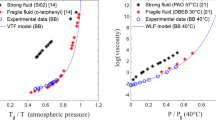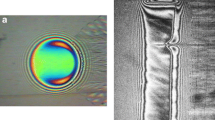Abstract
In this study, the infrared temperature mapping technique, originally developed by Sanborn and Winer (Trans ASME J Tribol 93:262–271, 1971) and extended by Spikes et al. (Tribol Lett 17(3):593–605, 2004), has been made more sensitive and used to study the temperature rise of elastohydrodynamic contacts in pure rolling. Under such conditions lubricant shear heating within the contact is considered negligible and this allows temperature changes due to lubricant compression to be investigated. Pure rolling surface temperature distributions have been obtained for contacts lubricated with a range of lubricants, included a group I, and group II mineral oil, a polyalphaolefin (group IV), the traction fluid Santotrac 50 and 5P4E, a five-ring polyphenyl-ether. Resulting maps show the temperature rise in the contact increases in the inlet due to compression heating and then decreases and in most cases becomes negative in the exit region due to the effect of decompression. Temperature changes increase with entrainment speed but in the current tests are always very small, and less than 1 °C. Contact temperature rises from compression were compared to those from sliding contacts (where a slide-roll ratio of 0.5 was applied). Here the contribution to the contact temperature from compression is shown to decrease dramatically with entrainment speed. The lubricant 5P4E is found to behave differently from other lubricants tested in that it showed a peak in temperature at the outlet. This effect becomes more pronounced with increasing speed, and has tentatively been attributed to a phase change in the exit region. Using moving heat source theory, the measured temperature distributions have been converted to maps showing rate of heat input into each surface and the latter compared with theory. Qualitative agreement between theory and experiment is found, and a more accurate theoretical comparison is the subject of ongoing study.















Similar content being viewed by others
Abbreviations
- α:
-
Pressure–viscosity coefficient (GPa−1)
- ε:
-
Coefficient of thermal expansivity (k−1)
- χ :
-
Thermal diffusivity of surface material (m2/s)
- ρ :
-
Mass density of surface material (kg/m3)
- σ :
-
Specific heat of surface material (J/kg K)
- η :
-
Lubricant dynamic viscosity (Pa s)
- η 0 :
-
Lubricant dynamic viscosity at inlet (Pa s)
- δT :
-
Temperature rise due to single heat source (°C)
- A :
-
Area of element in thermal analysis (m2)
- C :
-
Jaeger heat transfer coefficient (km2/W)
- c :
-
Pressure thermal expansivity coefficient (Pa−1)
- h :
-
Film thickness (m)
- i, j:
-
Locations of temperatures (dimensionless)
- k, l:
-
Locations of heat inputs (dimensionless)
- K :
-
Thermal conductivity of the surface material (W/mK)
- p r :
-
Hertzian pressure (GPa)
- p max :
-
Maximum Hertzian pressure (GPa)
- \( \dot{q} \) :
-
Heat flux per unit area into surface (W/m2)
- R :
-
Distance between points of heat input and temperature rise (m)
- T :
-
Absolute temperature of contact (K°)
- ΔT :
-
Temperature rise due to collection of heat sources (°C)
- ΔU :
-
Mean velocity of lubricant through the film (m)
- x, y:
-
Locations of heat inputs and temperature rises (m)
References
Gohar, R.: Elastohydrodynamics, 2nd edn, p. 237. Imperial College Press, London (2001)
Sanborn, D.M., Winer, W.O.: Fluid rheological effects in sliding elastohydrodynamic point contacts. Trans. ASME J. Tribol. 93, 262–271 (1971)
Spikes, H.A., Anghel, V., Glovnea, R.: Measurement of the rheology of lubricant films in elastohydrodynamic contacts. Tribol. Lett. 17(3), 593–605 (2004). doi:10.1023/B:TRIL.0000044509.82345.16
Reddyhoff, T., Spikes, H.A., Olver, A.V.: Improved temperature mapping of elasto-hydrodynamic contacts. Proc. Inst. Mech. Eng. Part J (2009) (in press)
Jagi, K., Kyogoku, K., Nakahara, T.: Measurements of temperature distributions around longitudinally grooved rough surfaces in sliding elastohydrodynamic point contacts. Tribol. Trans. 49, 282–289 (2006)
Imado, K., Kidol, Y., Miyagawal, H., Hirano, F.: A study of temperature rise in oil due to compression. Proc. Inst. Mech. Eng. Part J 212, 291–299 (1998). doi:10.1243/1350650981542100
Salehizadeh, H., Sake, K.: Thermal non-newtonian elastohydrodynamic lubrication of roiling line contacts. ASME J. Tribol. 113, 481–491 (1991). doi:10.1115/1.2920649
Kaneta, M., Shigeta, T., Yang, P.: Effects of compressive hearting on traction force. Trans. ASME J. Tribol. 127, 435–442 (2005). doi:10.1115/1.1843153
Sadeghi, F., Sui, P.C.: Thermal elastohydrodynamic lubrication of rolling/sliding contacts. ASME. J. Tribol. 112, 189–195 (1990). doi:10.1115/1.2920241
Kim, H.K., Sadeghi, F.: Three dimensional temperature distribution in EHD lubrication: part I—circular contact. Trans. ASME J. Tribol. 114, 32–41 (1992). doi:10.1115/1.2920864
Fairlie, R., Goodyer, C.E., Berzins, M., Scales, L.E.: Numerical modelling of thermal effects in elastohydrodynamic lubrication solvers. In: Dowson, D., Lubrecht, A.A., Dalmaz, G., Priest, M. (eds.) Tribological Research and Design for Engineering Systems, Proceedings of the 29th Leeds-Lyon Symposium on Tribology, pp. 675–683. Elsevier Science, Amsterdam (2003)
Ausherman, V.K., Nagaraj, H.S., Sanborn, D.M., Winer, W.O.: Infrared temperature mapping in elastohydrodynamic lubrication. Trans. ASME 98, 236–243 (1976)
Pandey, R.K., Ghosh, M.K.: Thermal effects on film thickness and traction in rolling/sliding EHL line contacts-an accurate inlet zone analysis. Wear 192, 118–127 (1996). doi:10.1016/0043-1648(95)06778-7
Pandey, R.K., Ghosh, M.K.: A thermal analysis of traction in elastohydrodynamic rolling/sliding line contacts. Wear 216, 106–114 (1996). doi:10.1016/S0043-1648(98)00151-3
Bair, S.: Accurate measurements of pressure-viscosity behaviour in lubricants. Trans. ASME J. Tribol. 45, 390–396 (2002). doi:10.1080/10402000208982564
Jacobson, B.: A high pressure-short time shear strength analyzer for lubricants. Presented at the ASME-ASLE Joint Lubrication Conference, San Diego, California. J. Tribol. 107, 220–223 (1984)
Sugimura, J., Hashimoto, M., Yamamoto, Y.: Study of elastohydrodynamic contacts with fluorescence microscope. In: Dowson, D., et al. (eds.) Thin Films and Tribological Interfaces, pp. 609–617. Elsevier, Amsterdam (2000)
Evans, C.R., Johnson, K.L.: Rheological properties of elastohydrodynamic lubricants. Proc. Inst. Mech. Eng. 200(C5), 303–312 (1986)
Rudnick, L.R.: Synthetics, Mineral Oils, and Bio-Based Lubricants: Chemistry and Technology. Taylor & Francis, Boca Raton (2006)
Evans, C.R., Johnson, K.L.: Regimes of traction in elastohydrodynamic lubrication. Proc. Inst. Mech. Eng. 200(C5), 313–324 (1986)
Hamrock, B.J., Dowson, D.: Ball Bearing Lubrication, the Elastohydrodynamics of Elliptical Contacts. Wiley, London (1981)
Jaeger, J.C.: Moving sources of heat and temperature at sliding contacts. Proc. R. Soc. NSW 76, 203–224 (1942)
Bos, J., Moes, H.: Frictional heating of tribological contacts. Trans. ASME J. Tribol. 117, 171–176 (1995). doi:10.1115/1.2830596
Johnston, G.J., Wayte, R., Spikes, H.A.: The measurement and study of very thin lubricant films in concentrated contacts. Tribol. Trans. 34, 187–194 (1991). doi:10.1080/10402009108982026
Crook, A.W.: The lubrication of rollers, III theoretical discussion of friction and the temperatures in the oil film. Proc. R. Soc. Lond. 254(1040), 237–258 (1961)
Cheng, H.S., Sternlicht, B.: A numerical solution for pressure, temperature, and film thickness between two infinitely long, lubricated rolling and sliding cylinders under heavy loads. ASME J. Basic Eng. 87, 695–707 (1965)
Larsson, R., Larsson, P.O., Eriksson, E., Sjoberg, M., Huglund, E.: Lubricant properties for input to hydrodynamic and elastohydrodynamic lubrication analyses. Proc. Inst. Mech. Eng. Part J 214, 17–27 (2000)
Cann, P.M., Spikes, H.A.: Measurement of pressure distribution in EHL—development of method and application to dry static contacts. Trans. ASME J. Tribol. 48(4), 474–483 (2005)
Gardiner, D.J., Baird, E., Craggs, C., Dare-Edwards, M.P., Bell, J.C.: Raman microspectroscopy of a working elastohydrodynamic contact. Lubr Sci. 1, 301–313 (1989). doi:10.1002/ls.3010010402
Anghel, V., Glovnea, R.P., Spikes, H.A.: Friction and film-forming behaviour of five traction fluids. J. Synth. Lubr 21, 13–32 (2004). doi:10.1002/jsl.3000210103
Author information
Authors and Affiliations
Corresponding author
Rights and permissions
About this article
Cite this article
Reddyhoff, T., Spikes, H.A. & Olver, A.V. Compression Heating and Cooling in Elastohydrodynamic Contacts. Tribol Lett 36, 69–80 (2009). https://doi.org/10.1007/s11249-009-9461-3
Received:
Accepted:
Published:
Issue Date:
DOI: https://doi.org/10.1007/s11249-009-9461-3




